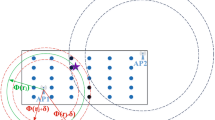Abstract
In recent years, indoor fingerprint-based localization algorithm has been widely used by applications on smart phone. In these localization algorithms, it’s very popular to use WiFi signal characteristics to represent the location fingerprint. With the fast popularization of WiFi, the WiFi access points (APs) could be seen everywhere. However, as the number of APs increases, the dimension of the fingerprint and the complexity of fingerprint-based localization algorithm subsequently increase. Responding to the above challenges, this paper proposes a novel indoor localization algorithm MAPS (indoor localization algorithm based on multiple access point selection). MAPS could effectively reduce the complexity of localization computation, and improve the performance of localization through AP selection method. With the first round AP selection, MAPS can obtain a stable subset of AP, thus reducing the dimension of fingerprint, and obtaining better discrimination. And with the second round of AP selection, AP subset could be further condensed to construct a decision tree in each location cluster. This step can further improve the localization performance. The experimental results shown, as compared with classical indoor localization algorithm, MAPS has better positioning accuracy, and could achieve the accuracy of over 90% within 2m location error.





Similar content being viewed by others
References
Kaemarungsi K, Krishnamurthy P (2004) Modeling of indoor positioning systems based on location fingerprinting, Twenty-third AnnualJoint Conference of the IEEE Computer and Communications Societies. IEEE, vol 2, pp 1012–1022
Youssef MA, Agrawala A, Shankar AU (2003) WLAN location determination via clustering and probability distributions. Proceedings of the 1st IEEE international conference on pervasive computing and communications, pp 143–150
Du L, Bai Y, Chen L (2007) Access point selection strategy for large-scale wireless local area networks. IEEE Wireless Communications and Networking Conference 2007:2161–2166
Chen Y, Yang Q, Yin J, et al. (2006) Power-efficient access-point selection for indoor location estimation. IEEE Trans Knowl Data Eng 18(7):877–888
Zhao Q et al (2010) An effective preprocessing scheme for WLAN-based fingerprint positioning systems, 2010 12th IEEE international conference on communication technology (ICCT)
Kushki A, Plataniotis KN, Venetsanopoulos AN (2007) Kernel-based positioning in wireless local area networks. IEEE Trans Mobile Comput 6(6):689–705
Zou G et al (2014) An indoor positioning algorithm using joint information entropy based on WLAN fingerprint, 2014 International conference on computing, communication and networking technologies (ICCCNT)
Laoudias C, Panayiotou CG, Kemppi P (2010) On the RBF-based positioning using WLAN signal strength fingerprints, 2010 7th workshop on positioning navigation and communication (WPNC)
Liang D, Zhang Z, Peng M (2015) Access point reselection and adaptive cluster splitting-based indoor localization in wireless local area networks. IEEE Internet of Things Journal 2(6):573–585
Zhou M, Wei Y, Tian Z, et al. (2017) Achieving cost-efficient indoor fingerprint localization on WLAN platform: A hypothetical test approach. IEEE Access 5:15865–15874
Jia B, Huang B, Gao H, et al. (2019) Selecting critical WiFi APs for indoor localization based on a theoretical error analysis. IEEE Access 7:36312–36321
Duda RO, Hart PE, Stork DG (2012) Pattern classification [M]. Wiley, New York
Quinlan JR (2014) C4. 5: programs for machine learning [M]. Elsevier
Acknowledgements
The financial support of the program of Key Industry Innovation Chain of Shaanxi Province, China (2017ZDCXL-GY-04-02), of the program of Xi’an Science and Technology Plan (201805029YD7CG13(5) ), Shaanxi, China, of Key R&D Program C The Industry Project of Shaanxi (Grant No. 2018GY-017), of Key R&D Program C The Industry Project of Shaanxi (Grant No. 2017GY-191) and of Education Department of Shaanxi Province Natural Science Foundation, China (15JK1742) are gratefully acknowledged.
Author information
Authors and Affiliations
Corresponding author
Additional information
Publisher’s Note
Springer Nature remains neutral with regard to jurisdictional claims in published maps and institutional affiliations.
Rights and permissions
About this article
Cite this article
Huang, P., Zhao, H., Liu, W. et al. MAPS: Indoor Localization Algorithm Based on Multiple AP Selection. Mobile Netw Appl 26, 649–656 (2021). https://doi.org/10.1007/s11036-019-01411-7
Published:
Issue Date:
DOI: https://doi.org/10.1007/s11036-019-01411-7




